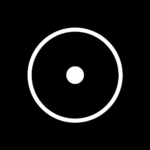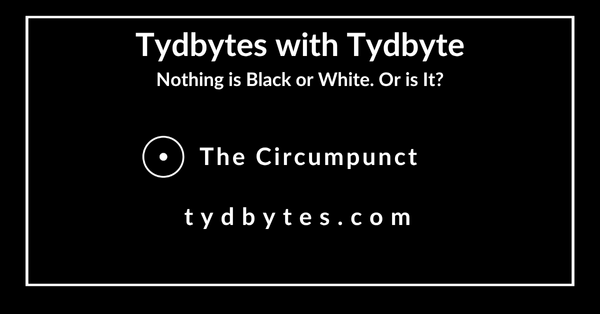The The Circumpunct is a universal symbol of unity, source, and sun. At first glance, the Circumpunct, just a dot within a circle, might seem deceptively simple. Yet this ancient glyph has echoed across civilizations, philosophies, and spiritual traditions for millennia.

Profound Symbolic Weight
Known also as the “circled dot” or “point within a circle” or “dot within a circle”, the Circumpunct carries profound symbolic weight: it represents the origin of creation, the center of consciousness, and the radiant power of the sun.
For creators, educators, and seekers, the Circumpunct offers a powerful tool: a symbol that speaks to unity without words. Whether used as a spiritual overlay, a design motif, or a meditative anchor, it carries a timeless message:
Return to center. Begin again.
The Circumpunct: Portal, Pulse, and Playground
The Circumpunct is the silent heartbeat of the Tydbyte mythos, symbol that anchors both LookSee and Tydbyte in their cosmic improvisation.
For Tydbyte, it’s the origin point of riffing: the dot of spontaneous insight encircled by the spacious field of possibility. It’s where wisdom begins as a whisper and spirals outward into playful teaching.
For LookSee, the Circumpunct is a lens and a wink. It’s the eye that sees through illusion, the center that invites perception to return to stillness. Googly-eyed and grounded, LookSee dances around the Circumpunct, reminding us that clarity and absurdity share the same source.
Together, they treat the Circumpunct not as a static symbol, but as a living overlay—a tool for teaching, a design motif, and a metaphysical compass. It’s the “I AM” before the riff, the breath before the byte.
Origins in Ancient Egypt: The Solar Eye
The earliest known use of the circumpunct traces back to ancient Egypt, where it symbolized Ra, the sun god. In hieroglyphs, the dot within a circle denoted the midday sun—pure, centered, and life-giving. Ra was not just a celestial body but a divine force of illumination and order. The circumpunct thus became a visual shorthand for cosmic clarity and divine presence.
Kabbalah: Keter in The Tree of Life
In Kabbalistic thought, the Circumpunct—a dot within a circle—can be seen as a visual metaphor for the sefirah of Keter, the crown and origin point of divine emanation. Keter is the unknowable source, the pure potential from which all creation flows. Like the dot at the center of the circle, it is both hidden and central, representing the infinite light (Ein Sof) before it begins to manifest through the Tree of Life.
The circle surrounding the dot evokes the concept of the Ohr Makif, the encompassing light that surrounds all existence. In contrast to the inner light (Ohr Penimi), which enters and animates vessels, the surrounding light is transcendent—beyond grasp, yet always present. The Circumpunct thus becomes a symbolic bridge between immanence and transcendence, between the finite and the infinite.
Some Kabbalists interpret the dot as the spark of divine will, the primal “I AM” that precedes thought and form. It is the point of pure intention, the seed of creation. The circle, then, is the vessel—the space in which divine will begins to shape reality. This mirrors the dynamic between Keter and Chokhmah, where the initial impulse (dot) expands into wisdom and structure (circle).
Kabbalah Meditation and Mystical Practice
In meditation and mystical practice, focusing on the Circumpunct can serve as a gateway to unity consciousness. It invites the practitioner to return to center, to the silent origin before multiplicity. Just as the Tree of Life begins with a single point and unfolds into ten sefirot, the Circumpunct reminds us that all complexity arises from simplicity—and all paths lead back to source.
Hinduism and the Bindu: Creation from Stillness
In Hindu metaphysics, the dot at the center of the circle is called the bindu. It represents the unmanifested potential of the universe—the seed point from which all creation emerges. In tantric and yogic traditions, the bindu is the focal point of the mandala, the gateway between the finite and the infinite. It is both the origin and the destination, the stillness before movement.
Bindu also carries masculine connotations, symbolizing the essence of life and the spark of consciousness. In meditation, focusing on the bindu is said to align the practitioner with the source of all being.
Greek Philosophy: The Monad and the Infinite
For the Pythagoreans and later Neoplatonists, the Circumpunct represented the Monad—the singular source from which all numbers, forms, and realities arise. It was the point of pure being, untouched by duality. The circle, enclosing the point, symbolized eternity and wholeness. Together, they formed a metaphysical diagram of unity: the One that contains all.
This idea influenced early Christian mysticism and Gnostic thought, where the Circumpunct became a symbol of divine origin and the unknowable essence of God.
Freemasonry: The Point Within the Circle
In Masonic tradition, the Circumpunct appears in the First Degree ritual as “the point within a circle,” flanked by two parallel lines representing St. John the Baptist and St. John the Evangelist. This configuration teaches moral boundaries and spiritual balance. The point is the individual; the circle is the boundary of conduct; the lines are the pillars of wisdom and faith.
Manly P. Hall, a 33rd-degree Mason and esoteric scholar, described the dot, line, and circle as the keys to all knowledge: universal consciousness, intelligence, and force. The circumpunct, then, is not just symbolic—it’s instructional.
Alchemy and Astronomy: Gold and the Sun
In alchemical texts, the Circumpunct denotes gold—the most noble of metals, associated with purity, incorruptibility, and solar energy. In astronomy, it represents the sun itself, the gravitational center of our solar system and the source of light and life.
This dual use—material and celestial—reinforces the circumpunct’s role as a symbol of centrality, radiance, and transformation.
Modern Resonance: Logos, Road Signs, and Mindfulness
Today, the Circumpunct appears in unexpected places. It’s used in European road signs to indicate city centers. It’s embedded in corporate logos to suggest focus, clarity, and unity. In mindfulness and meditation apps, it often marks the breath or the present moment.
Its minimalist geometry makes it adaptable, but its symbolic depth ensures it never loses meaning. Whether in spiritual branding, educational design, or metaphysical storytelling, the Circumpunct invites us to return to center.
Why It Still Matters
In a fragmented world, the Circumpunct reminds us of wholeness. It’s a visual mantra: simple, centered, and eternal. Across cultures, it has signified the sun, the soul, the source, and the self.
The Circumpunct is a symbol that transcends language, pointing us back to the origin—where all paths begin and converge.
Tydbytes.com

Explore with Tydbyte
- Home
- Connect With Tydbyte
- Tydbyte
- Tydbyte's YouTube Channel
- Merch by Tydbyte
- Posts
- Pages
- Buy Me A Coffee
